Abstract
1. Very low concentrations of Pb2+ decrease the capacity of rat heart mitochondria, oxidizing pyruvate plus malate, to remove Ca2+ from the medium. 2. The primary effect is on the rate of Ca2+ sequestration; this is reflected in the overall extent of Ca2+ removal. 3. Pb2+ has at least two separate actions. Below about 0.5 nmol/mg of protein, it acts solely by competing with Ca2+ (Ki = 0.4 muM); above this concentration it also inhibits the production or use of respiratory energy, so that at 1 nmol of Pb2+/mg of protein, Ca2+ removal is almost completely abolished. 4. Pb2+ inhibits coupled and uncoupled respiratory O2 use by mitochondria oxidizing pyruvate plus malate, but at higher concentrations than those that affect Ca2+ removal; similar concentrations of Pb2+ inhibit pyruvate uptake, but not malate uptake, by the mitochondria. 5. Mg2+ only decreases Ca2+ removal by competition, and is a far-less effective competitor than Pb2+ (Ki = 0.15 mM). It is possible that the primary cause of the second effect of Pb2+ is displacement of membrane Mg2+. 6. The consequences of these results are discussed in terms of the possible involvement of heart mitochondria in excitation-contraction coupling, and the Pb2+ levels that might occur in heart tissue in vivo.
Full text
PDF
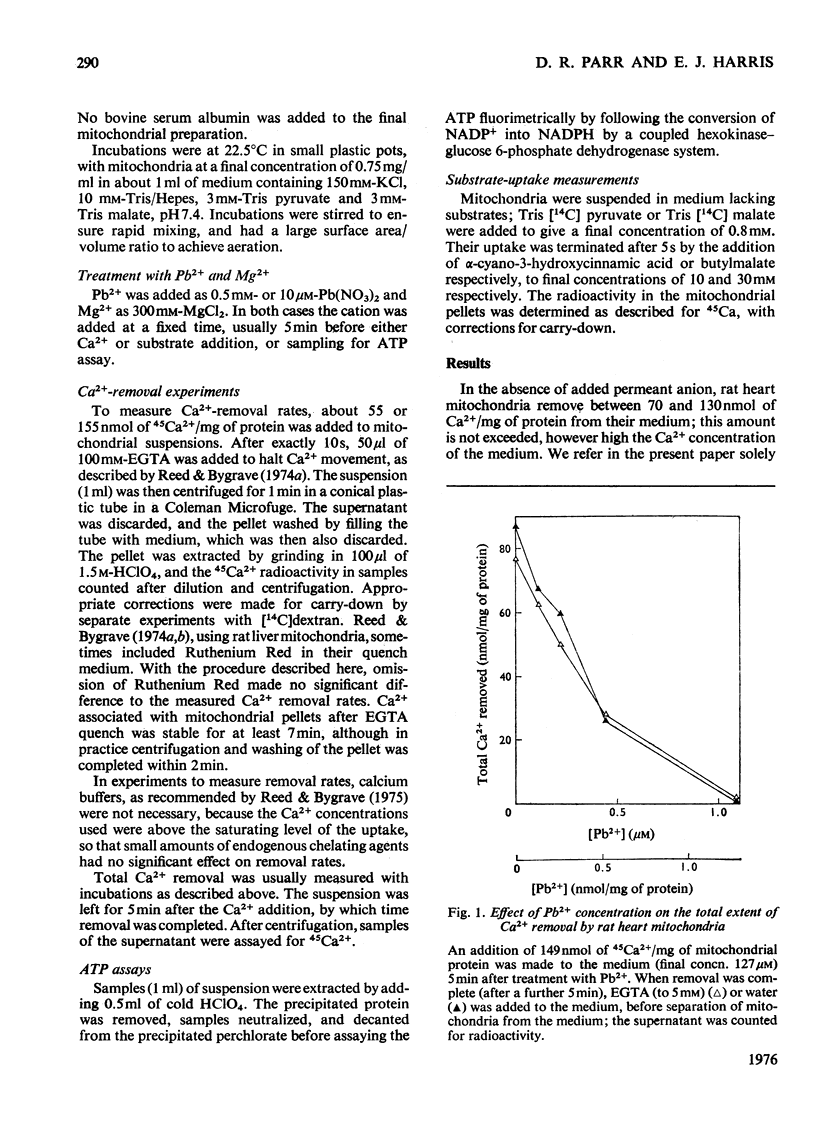
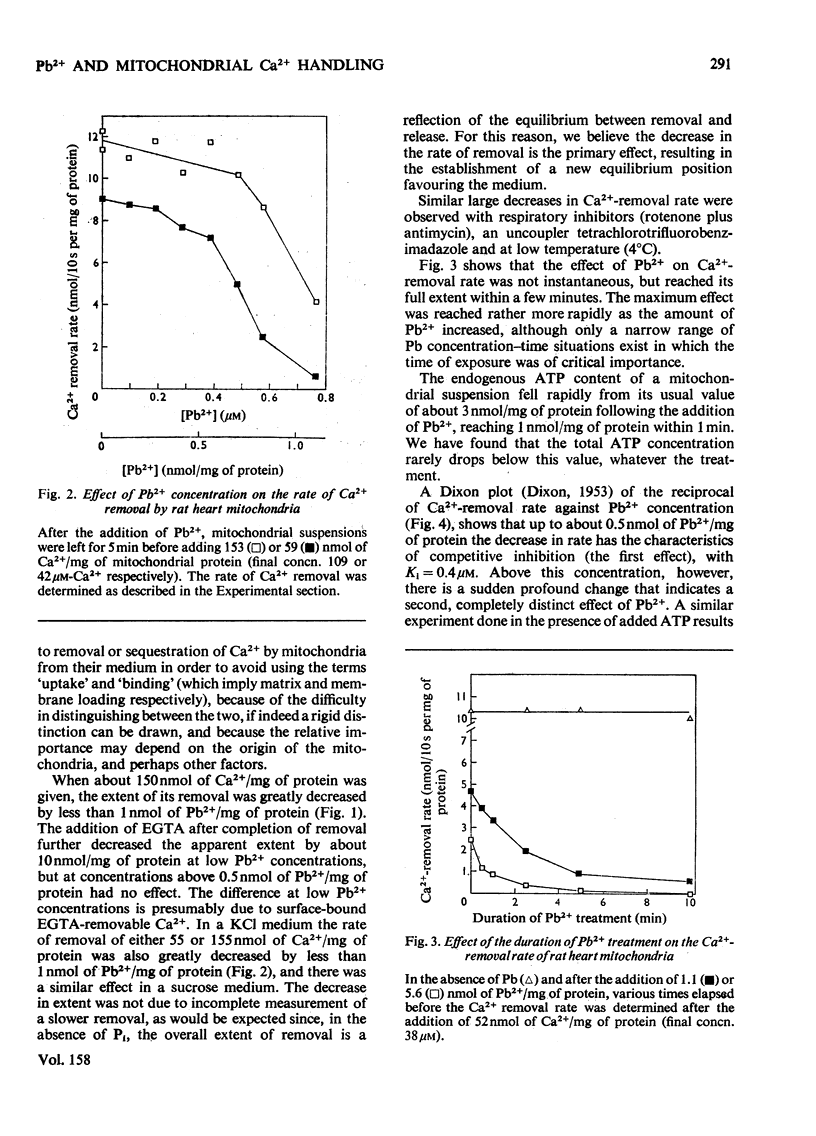
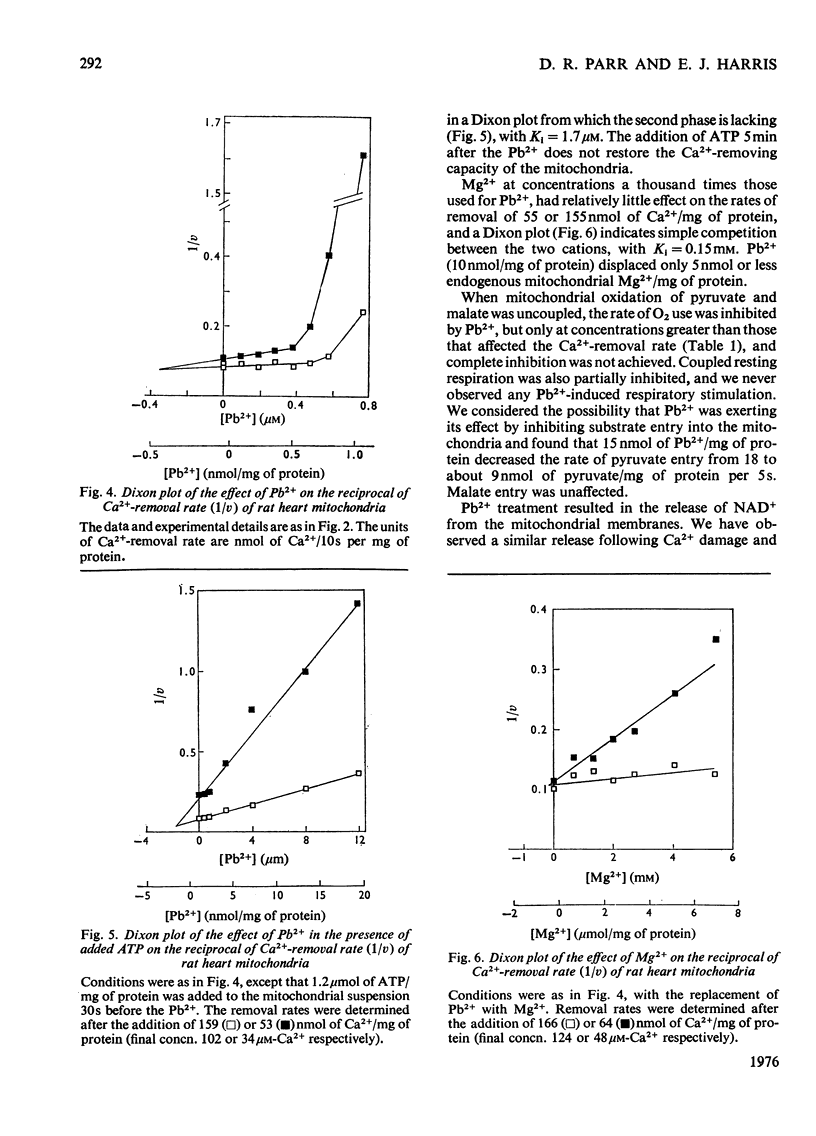
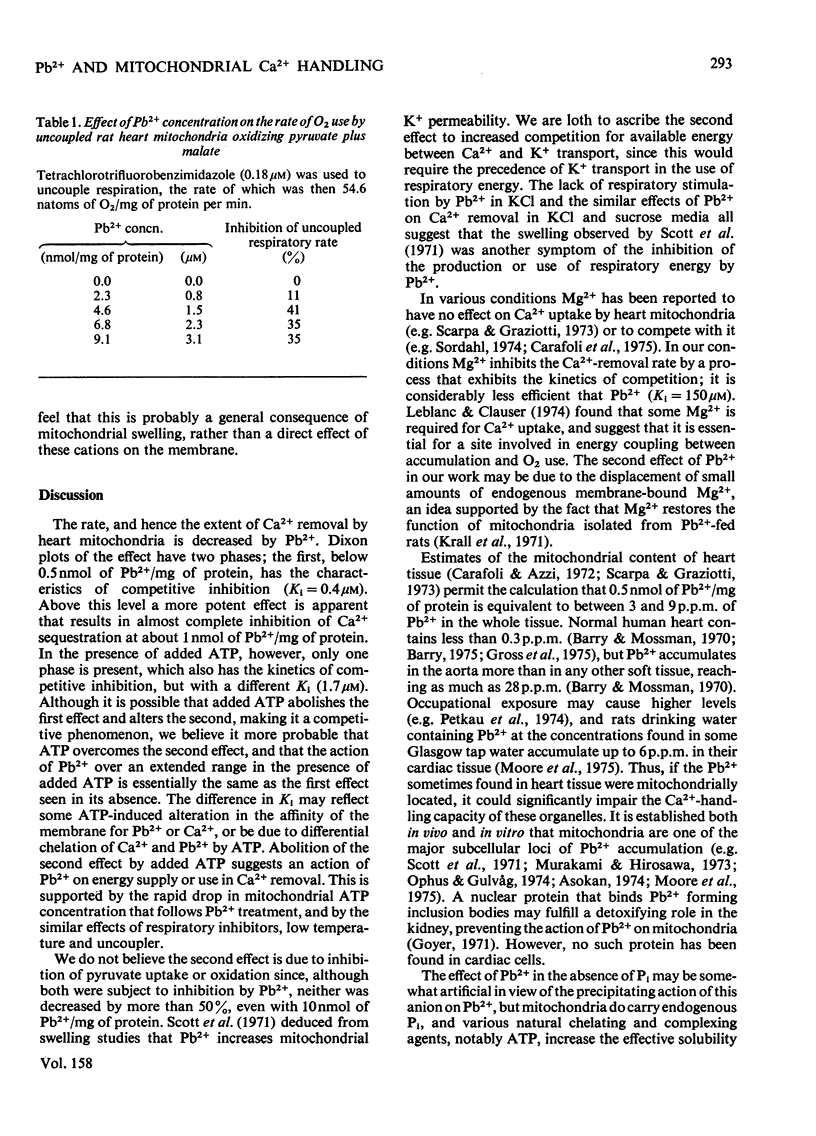
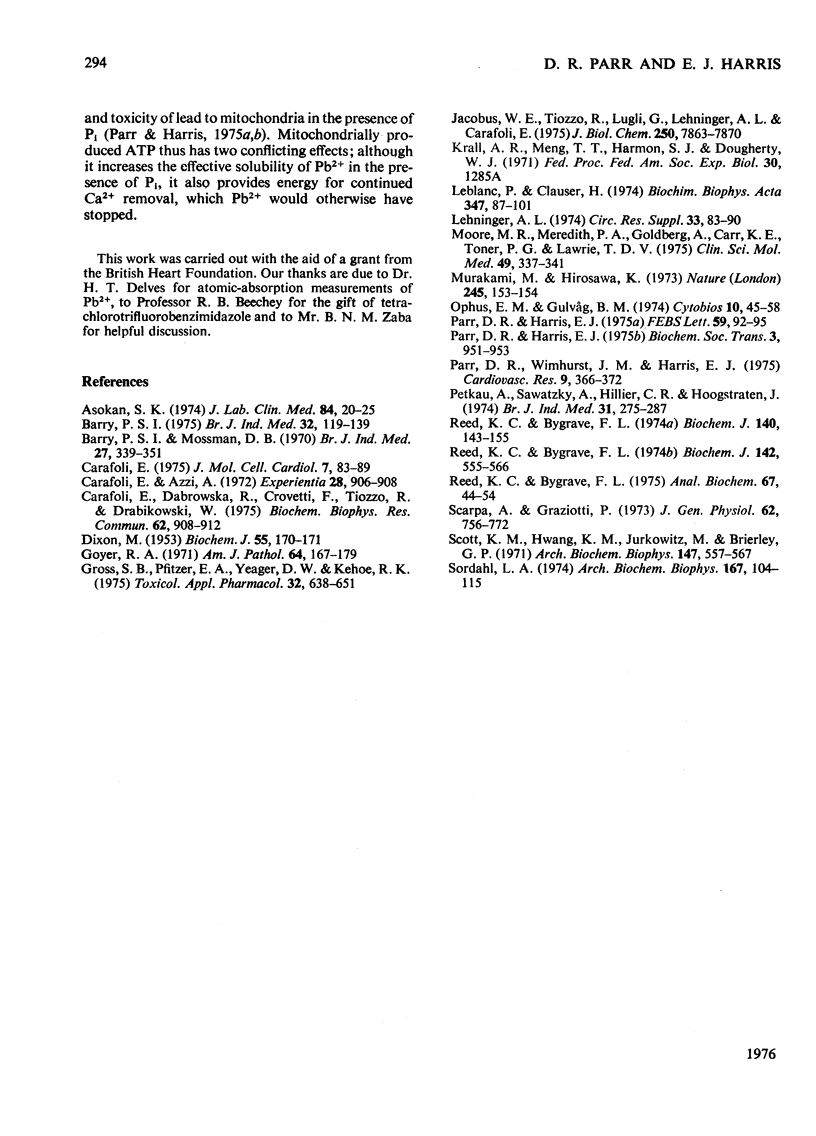
Selected References
These references are in PubMed. This may not be the complete list of references from this article.
- Asokan S. K. Experimental lead cardiomyopathy: myocardial structural changes in rats given small amounts of lead. J Lab Clin Med. 1974 Jul;84(1):20–25. [PubMed] [Google Scholar]
- Barry P. S. A comparison of concentrations of lead in human tissues. Br J Ind Med. 1975 May;32(2):119–139. doi: 10.1136/oem.32.2.119. [DOI] [PMC free article] [PubMed] [Google Scholar]
- Barry P. S., Mossman D. B. Lead concentrations in human tissues. Br J Ind Med. 1970 Oct;27(4):339–351. doi: 10.1136/oem.27.4.339. [DOI] [PMC free article] [PubMed] [Google Scholar]
- Carafoli E., Azzi A. The affinity of mitochondria for Ca ++ . Experientia. 1972 Aug 15;28(8):906–908. doi: 10.1007/BF01924937. [DOI] [PubMed] [Google Scholar]
- Carafoli E., Dabrowska R., Crovetti F., Tiozzo R., Drabikowski W. An in vitro study of the interaction of heart mitochondria with troponin-bound Ca2+. Biochem Biophys Res Commun. 1975 Feb 17;62(4):908–912. doi: 10.1016/0006-291x(75)90409-x. [DOI] [PubMed] [Google Scholar]
- Carafoli E. Mitochondria, Ca2+ transport and the regulation of heart contraction and metabolism. J Mol Cell Cardiol. 1975 Feb;7(2):83–87. doi: 10.1016/0022-2828(75)90010-3. [DOI] [PubMed] [Google Scholar]
- DIXON M. The determination of enzyme inhibitor constants. Biochem J. 1953 Aug;55(1):170–171. doi: 10.1042/bj0550170. [DOI] [PMC free article] [PubMed] [Google Scholar]
- Goyer R. A. Lead toxicity: a problem in environmental pathology. Am J Pathol. 1971 Jul;64(1):167–182. [PMC free article] [PubMed] [Google Scholar]
- Gross S. B., Pfitzer E. A., Yeager D. W., Kehoe R. A. Lead in human tissues. Toxicol Appl Pharmacol. 1975 Jun;32(3):638–651. doi: 10.1016/0041-008x(75)90127-1. [DOI] [PubMed] [Google Scholar]
- Jacobus W. E., Tiozzo R., Lugli G., Lehninger A. L., Carafoli E. Aspects of energy-linked calcium accumulation by rat heart mitochondria. J Biol Chem. 1975 Oct 10;250(19):7863–7870. [PubMed] [Google Scholar]
- Leblanc P., Clauser H. ADP and Mg2+ requirement for Ca2+ accumulation by hog heart mitochondria. Correlation with energy coupling. Biochim Biophys Acta. 1974 Apr 23;347(1):87–101. doi: 10.1016/0005-2728(74)90202-3. [DOI] [PubMed] [Google Scholar]
- Lehninger A. L. Ca2+ transport by mitochondria and its possible role in the cardiac contraction-relaxation cycle. Circ Res. 1974 Sep;35 (Suppl 3):83–90. [PubMed] [Google Scholar]
- Moore M. R., Meredith P. A., Goldberg A., Carr K. E., Toner P. G., Lawrie T. D. Cardiac effects of lead in drinking water of rats. Clin Sci Mol Med. 1975 Oct;49(4):337–341. doi: 10.1042/cs0490337. [DOI] [PubMed] [Google Scholar]
- Murakami M., Hirosawa K. Letter: Electron microscope autoradiography of kidney after administration of 210Pb in mice. Nature. 1973 Sep 21;245(5421):153–154. doi: 10.1038/245153a0. [DOI] [PubMed] [Google Scholar]
- Parr D. R., Harris E. J. Enhancement by chelating agents of lead toxicity to mitochondria in the presence of inorganic phosphate. FEBS Lett. 1975 Nov 1;59(1):92–95. doi: 10.1016/0014-5793(75)80348-6. [DOI] [PubMed] [Google Scholar]
- Parr D. R., Wimhurst J. M., Harris E. J. Calcium-induced damage of rat heart mitochondria. Cardiovasc Res. 1975 May;9(3):366–372. doi: 10.1093/cvr/9.3.366. [DOI] [PubMed] [Google Scholar]
- Petkau A., Sawatzky A., Hillier C. R., Hoogstraten J. Lead content of neuromuscular tissue in amyotrophic lateral sclerosis: case report and other considerations. Br J Ind Med. 1974 Oct;31(4):275–287. doi: 10.1136/oem.31.4.275. [DOI] [PMC free article] [PubMed] [Google Scholar]
- Reed K. C., Bygrave F. L. A re-evaluation of energy-independent calcium-ion binding by rat liver mitochondria. Biochem J. 1974 Sep;142(3):555–566. doi: 10.1042/bj1420555. [DOI] [PMC free article] [PubMed] [Google Scholar]
- Reed K. C., Bygrave F. L. Methodology for in vitro studies of Ca-2+ transport. Anal Biochem. 1975 Jul;67(1):44–54. doi: 10.1016/0003-2697(75)90270-5. [DOI] [PubMed] [Google Scholar]
- Reed K. C., Bygrave F. L. The inhibition of mitochondrial calcium transport by lanthanides and ruthenium red. Biochem J. 1974 May;140(2):143–155. doi: 10.1042/bj1400143. [DOI] [PMC free article] [PubMed] [Google Scholar]
- Scarpa A., Graziotti P. Mechanisms for intracellular calcium regulation in heart. I. Stopped-flow measurements of Ca++ uptake by cardiac mitochondria. J Gen Physiol. 1973 Dec;62(6):756–772. doi: 10.1085/jgp.62.6.756. [DOI] [PMC free article] [PubMed] [Google Scholar]
- Scott K. M., Hwang K. M., Jurkowitz M., Brierley G. P. Ion transport by heart mitochondria. 23. The effects of lead on mitochondrial reactions. Arch Biochem Biophys. 1971 Dec;147(2):557–567. doi: 10.1016/0003-9861(71)90413-9. [DOI] [PubMed] [Google Scholar]
- Sordahl L. A. Effects of magnesium, Ruthenium red and the antibiotic ionophore A-23187 on initial rates of calcium uptake and release by heart mitochondria. Arch Biochem Biophys. 1975 Mar;167(1):104–115. doi: 10.1016/0003-9861(75)90446-4. [DOI] [PubMed] [Google Scholar]


